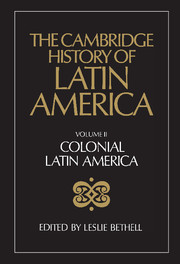Book contents
- Frontmatter
- PART ONE POPULATION
- PART TWO ECONOMIC AND SOCIAL STRUCTURES: SPANISH AMERICA
- PART THREE ECONOMIC AND SOCIAL STRUCTURES: BRAZIL
- PART FOUR INTELLECTUAL AND CULTURAL LIFE
- 16 Literature and intellectual life in colonial Spanish America
- 17 The architecture and art of colonial Spanish America
- 18 The architecture and art of colonial Brazil
- 19 The music of colonial Spanish America
- Bibliographical essays
18 - The architecture and art of colonial Brazil
from PART FOUR - INTELLECTUAL AND CULTURAL LIFE
Published online by Cambridge University Press: 28 March 2008
- Frontmatter
- PART ONE POPULATION
- PART TWO ECONOMIC AND SOCIAL STRUCTURES: SPANISH AMERICA
- PART THREE ECONOMIC AND SOCIAL STRUCTURES: BRAZIL
- PART FOUR INTELLECTUAL AND CULTURAL LIFE
- 16 Literature and intellectual life in colonial Spanish America
- 17 The architecture and art of colonial Spanish America
- 18 The architecture and art of colonial Brazil
- 19 The music of colonial Spanish America
- Bibliographical essays
Summary
No firm or well-defined tradition of town planning was brought by the Portuguese settlers to Brazil. Unlike Italy, France and Spain, neither the regular gridiron nor the radial town plan had had any currency in Portugal. The suggestion has been made by Robert Smith that when Salvador da Bahia was built on two levels, the upper connected to the lower town by steep lanes, a traditional Portuguese layout – represented by Lisbon, Coimbra and Oporto, for example – was being followed. This suggestion remains conjectural. Certainly the fairly regular layout of upper Salvador, with four or five long, more or less parallel streets crossed at right angles by a dozen shorter ones, does have a few precedents in Portugal, especially in the north of the country, e.g. Bragança, Caminha, Viana do Castelo, Braga, Aveiro. Such orthogonal urban plans were part of the general western European cultural heritage derived from classical antiquity. Nevertheless they are not common in Portugal and comparatively rare in the early towns built by the Portuguese overseas. In Lusitanian India the fortress towns of Damaō and Bassein were constructed on regular orthogonal plans, and the layouts of Cochim and Sāo Tomé (Meliapor) were also basically orthogonal, though less regular.
The contrast between Portuguese colonial cities and those of Spanish America, particularly Mexico, has often been noticed. In Spanish America regular gridiron plans, confirmed from c. 1573 in the Leyes de Indias, are common. What has less often been observed is the contrast to be found in both empires between the capital city or administrative centre on the one hand and the mining town on the other.
- Type
- Chapter
- Information
- The Cambridge History of Latin America , pp. 747 - 770Publisher: Cambridge University PressPrint publication year: 1984



